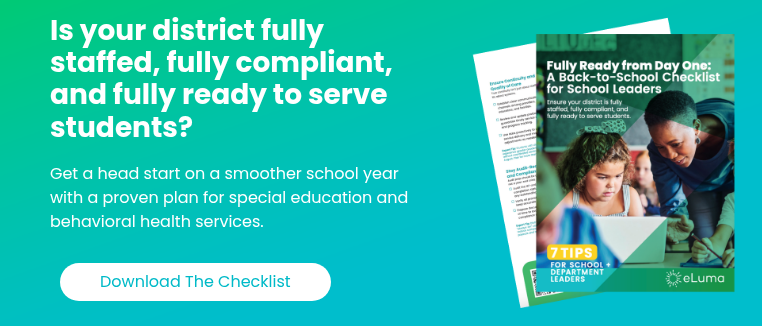Compliance gaps do more than indicate missed deadlines. They reveal deeper issues like service delivery shortfalls, staffing breakdowns, and missed opportunities to support students.
As the new school year approaches, many districts are sitting on a powerful asset: their special education data. This information can highlight which students missed services, where IEP timelines slipped, and what needs to change before school starts again.
This blog will teach you how to transform compliance data into a blueprint for improvement to boost both accountability and student outcomes.

Key Takeaways
- Compliance gaps highlight deeper challenges, such as missed services and staffing shortages, not just missed deadlines.
- Special education data can reveal patterns and guide targeted service delivery and staffing improvements.
- Flexible partnerships help districts maintain support despite staffing and changes in student needs.
- Collaboration and professional development ensure data-forward systems run smoothly.
1. Understand What Compliance Gaps Actually Reveal
It is easy to view special education compliance as a checklist of legal requirements, but every gap tells a deeper story.
When your data reveals:
- Lagging IEP service minutes
- Late evaluations or re-evaluations
- Overloaded caseloads or chronic provider absences
These are not isolated problems. They often reflect systems under strain where teams are short-staffed, disconnected, or working without timely access to the data they need.
“When a student doesn’t receive the service minutes listed in their IEP, it puts them at risk of losing skills and puts the district at risk of state complaints and due process proceedings. To prevent this, districts need to find and fix the root causes of lagging service time.”
– Brandy Samuell M.Ed.., Director of Mental Health and Related Services at eLuma
According to the Public Consulting Group (PCG), districts often use data systems primarily for mandated reporting. But those same systems can do much more. When used strategically, special education data can drive improvements in instruction, placement decisions, and service delivery across the district.

2. Turn Compliance Data Into an Action Plan
If your compliance data shows service gaps, you are not alone. But the most effective districts go beyond acknowledging the problem. They use that data to make specific, student-centered improvements.
Look for patterns, not just problems
Start by identifying which services, campuses, or student groups experienced repeated breakdowns. This step helps determine whether the issue is isolated or systemic.
Connect data to instructional decisions
Districts that use special education management systems to examine service logs, placement trends, and IEP timelines can identify what went wrong and how to fix it. For example, one district used its data to adjust assessment decisions and placements, resulting in increased achievement for students with disabilities.
Prioritize compensatory services
Use service logs and IEP progress data to identify which students are owed make-up time. Address these needs proactively before fall referrals and caseloads increase.
Forecast and adjust staffing
If missed services were due to unfilled positions or absences, use that data to guide summer hiring, service model adjustments, or partnerships with staffing providers.
3. Build Scalable Solutions to Expand Capacity
Compliance issues often stem from an overwhelmed system, not a lack of effort or knowledge. When staff are stretched thin, even the best processes break down. Many districts choose to partner with flexible service providers like eLuma, who can help them expand or contract their student support services based on current needs.
This approach gives schools the ability to adjust staffing in response to a range of situations, from long-term vacancies to sudden short-term needs like medical or maternity leave.
Instead of scrambling to cover gaps, districts can tap into support that matches their changing capacity. Having this flexibility makes it easier to maintain consistent services and protect compliance, even when circumstances shift unexpectedly.

4. Foster Strong Collaboration and Co-Teaching Practices
Data-driven plans are only as effective as the teamwork behind them. Building strong collaboration between general and special education staff is essential to turning insights into meaningful student support. When teams co-teach and communicate regularly, they can share data, coordinate interventions, and respond quickly to shifting student needs.
Creating intentional structures for collaboration helps break down silos and ensures everyone is working toward shared goals. Co-teaching models, joint planning sessions, and open data sharing promote alignment and consistency in service delivery.
“In addition to increasing instructional efficiency, co-teaching allows a subject matter expert and an expert in specialized instruction to create learning experiences that are impactful as well as meaningful to all students.”
– Brandy Samuell, M.Ed., Director of Mental Health and Related Services at eLuma
Providing ongoing professional development focused on collaboration and data use empowers educators to refine their practices and deepen their partnerships.
When educators feel connected and supported to problem-solve together, they can better adapt to challenges and improve outcomes for students with disabilities. Investing in collaboration and training strengthens your district’s capacity to act on data and builds a culture where continuous improvement and student-centered support thrive.
How eLuma Helps Districts Take Action
At eLuma, we know that staffing shortages and compliance concerns do not wait. That is why we partner with school districts to fill critical gaps quickly and build long-term systems of supports.
Our online, hybrid, and in-person therapy and student support solutions provide:
- Experienced, credentialed providers who deliver IEP-aligned services in speech therapy, occupational therapy, counseling, and more
- Flexible service models, including fully virtual, hybrid, or on-site support based on your needs
- Real-time service tracking and documentation tools in our Insight™ reporting software to keep you ahead of compliance deadlines
- Ongoing support and quality assurance, helping your teams feel confident and covered
The end of the year is not just a time to finalize reports. It is a chance to reflect, realign, and refocus your district’s special education strategy.
Let eLuma help you use your data to strengthen compliance, reduce gaps, and better serve students with disabilities.
Frequently Asked Questions
How do we prioritize which compliance gaps to address first when resources are limited?
Start by focusing on gaps that directly affect student access to services, such as missed therapy minutes or overdue evaluations. These have both immediate consequences for students and the highest risk for legal action. After that, look for patterns like repeated staffing shortages at certain sites that could cause ongoing issues if left unresolved.
Utilize resource mapping tools, like eLuma’s Impact Map, to see what supports you already have, where the gaps are, and how to make smarter, more strategic decisions about using every available resource, without adding new programs or funding.
What tools or systems make it easier to analyze special education data for patterns and trends?
Use special education management platforms that offer real-time service tracking, customizable reports, and dashboards with key compliance indicators.
Systems that connect service documentation with staffing and caseload data help you spot problems early and respond effectively. eLuma’s Insight™ platform is one example that supports both compliance monitoring and service delivery tracking.
How can we build stronger collaboration between general and special education teams when time for joint planning is limited?
Short, structured check-ins like weekly huddles or shared planning documents can make a difference. Leaders can also create space for collaboration through professional development days or by including co-planning time in regular team meetings. Focusing on shared goals and using simple communication tools helps strengthen collaboration without adding extra meetings.
What should we look for in a flexible service provider to ensure they meet both student needs and compliance standards?
Look for providers who offer credentialed, experienced staff aligned with IEP goals and state requirements. They should give you transparent service documentation, maintain open communication with your teams, and be flexible as your needs change. Strong providers also offer ongoing support and quality checks, not just staffing coverage.


